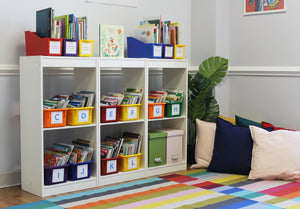A Look at How We Carefully and Accurately Level Spanish Books
Our Lead Curator and former dual language teacher, Marie Bouteillon, will walk you through a dozen books at these lower levels to explain the criteria she considers when leveling, and how to effectively teach at each reading level.
Video Transcript
Hi!
My name is Marie Bouteillon. I’m a former dual language teacher, and the Lead Curator at Hexagramm Books. Today, I’d like to show you how we level books.
We carefully level our Classroom Libraries, and each language receives special attention, in particular at the lower levels A through D. Leveled books are an American concept. That’s why most of the lower leveled books in our Spanish Classroom Libraries come from American publishers, and were translated from English to Spanish. Unfortunately, some publishers gave the exact same reading level to Spanish texts as they did to English texts. Yet, there are criteria to follow, and I’d like to show you how careful I was in leveling.
Drawing on my experience as a kindergarten teacher, I re-leveled over 800 titles in Spanish. Some wordless titles were supposedly at a level E. Other titles with extra long words in Spanish that were not high frequency words were leveled far too low. Some books had spelling mistakes. Others used false cognates. It took me 18 months to develop our Classroom Libraries, and that’s because I followed certain basic rules. Let me show you.
Level A
One thing I look for in level A books is that they hold a pattern from page to page, all the way to the last page. So here you see, esto es un triángulo, esto es un rectángulo”. The pictures offer very important support and there is little guessing involved. At level A, the pattern does not break on the last page. Teachers should always present a level A book. Presenting means reading the first page or the first two pages. The goal is for students to master one-to-one matching and carry the pattern from page to page. It is possible that some of the [fill in the blank] words used by students are different in terms of variation of Spanish. Students at this level are not supposed to look at the first letter to decode a tricky word. So, making a substitution of coche for auto is perfectly acceptable.

Level B
When leveling B books, I continue to look for a pattern. Level B books involve slightly more sight word knowledge and require looking more closely at the picture for clues. They also involve more inferring and looking at the first letter of a word to figure out tricky vocabulary. More importantly, I look for a break in the pattern on the last page. With level B books, the teacher should still introduce them by reading the title and the first page. Teachers will also want to introduce the concept of looking at the first letter of a tricky word, and cross-checking. For example, here the tricky word is not /m/ montaña, it’s /c/ colina.

Level C
Level C books begin to raise the bar. There’s often more text on each page, including a return sweep to a second line of text. There might be a little bit of dialogue introduced for the first time. ¡Ay no! ¡La bebita tiene hambre! is a form of dialogue, but without quotation marks. Level C is a great time to teach talking like a character or the narrator of a story. Students must be taught to pay much closer attention to the visual supports because the devil is in the details, and no longer in the big picture. For example, in the book En mi cabeza, students need to look at the type of hat, and the activity the character is doing. That’s also because there are two opportunities to figure out tricky words on each page. Some level C books may also require students to carry a pattern across two pages. To be a fluent reader at level C, students can decode basic two-syllable words, and know at least 50 sight words such as gusta, pongo, cuando, voy, este, en, mira, los, aquí.
Level D
Level D starts getting really exciting. We start to have some fun texts. We're getting past the emergent reader, and into a very early fluency reader. So the student will have some words that are a little harder, especially in terms of vocabulary. More often than not, there’s a problem solution at level D. Cómo es el cocodrilo? is an authentic text. It has some harder tricky words that require the reader to decode syllable by syllable. That's because at level D, you do expect the child to be able to decode 2- to 3- syllable words. It’s totally possible that a non-native Spanish speaker can decode the words without actually understanding what they’re reading. So, level D is also about checking for comprehension. Some of the texts at level D will have much less repetition, and can be easily decodable.
Marie Bouteillon is our Lead Curator at Hexagramm Books. She was a former kindergarten dual language teacher, and is now a dual language consultant. Find out more about her teaching tips for dual language teachers at Just Good Teaching.



Comments
Leave a comment